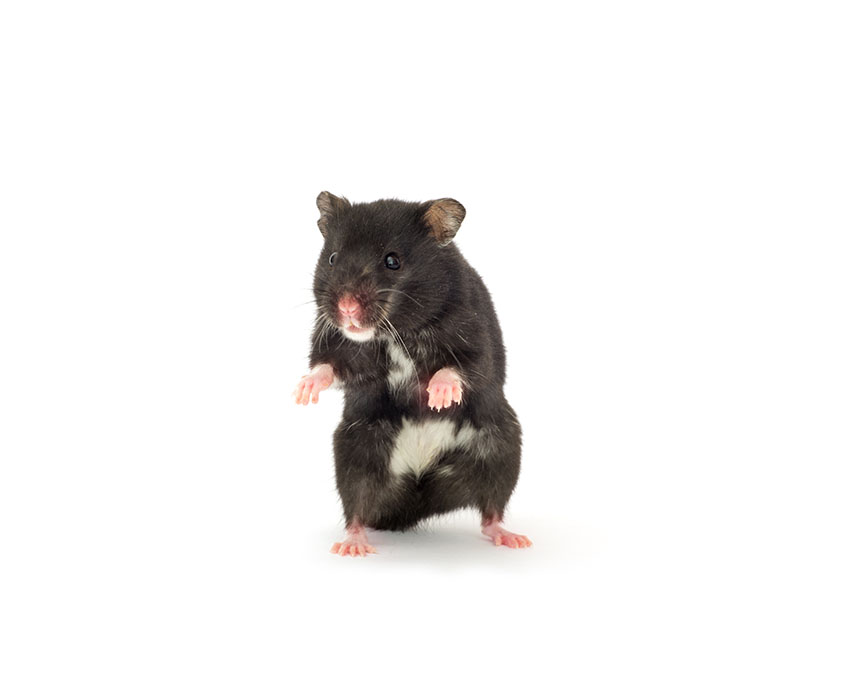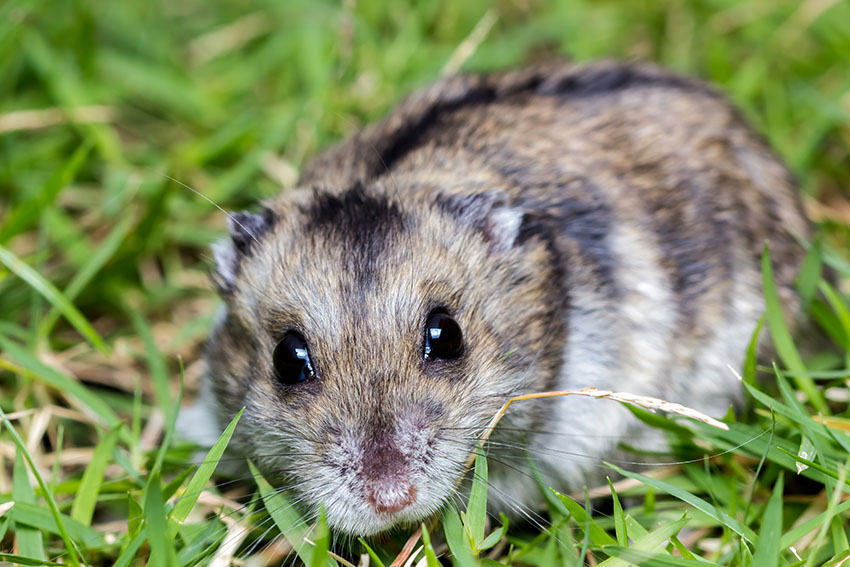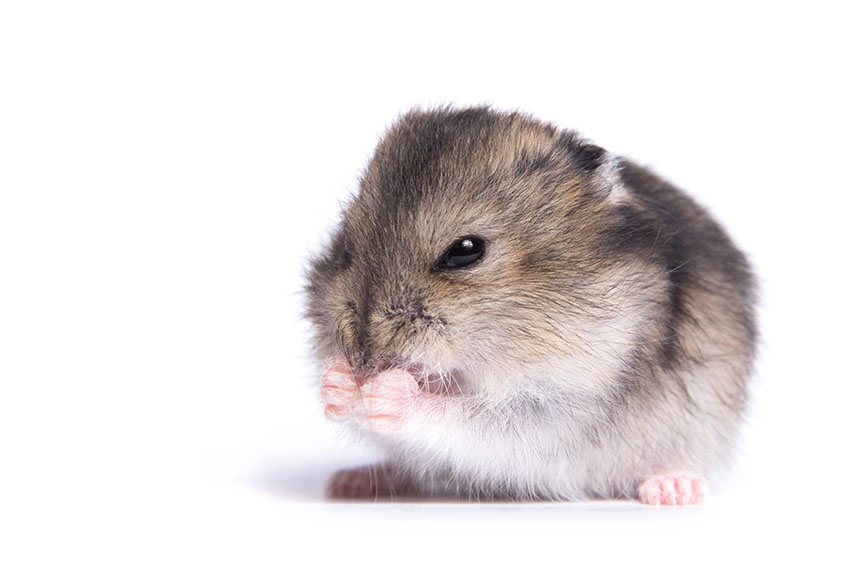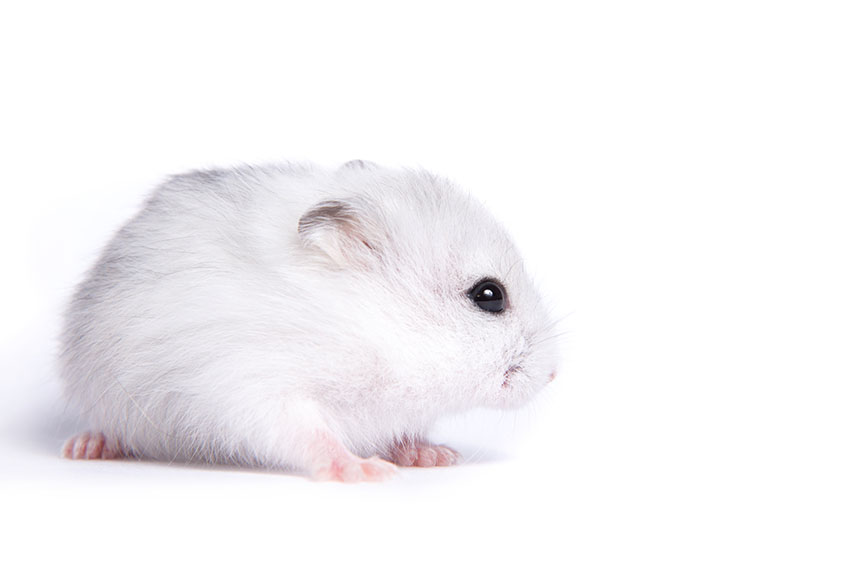The following are some of the most common hamster health issues. A good rule of thumb is to trust your own observations. If your pet appears to be in pain, is having trouble breathing or walking, is bleeding, not waking up as usual, or behaving in any way different to normal, consult a small-mammal vet as soon as possible.
Hamster Cuts And Scrapes
As with humans, hamster cuts and scrapes come about through contact with sharp or rough objects. If you notice a small wound or scrape, try to figure out what caused it, and then remove the danger from the hamster’s environment, or make sure the animal doesn’t revisit the dangerous place.
For small cuts, wash gently with lukewarm water on a ball of cotton wool. Don’t use any medicated product intended for humans, such as plasters, bandages, antiseptics or creams. If the wound is deep or bleeding a lot, take the hamster to the vet.

Healthy diet and clean water are great cure-alls. Make sure your pet gets all the essential vitamins and minerals, and this will help ward off infections
Hamster Abscesses
If hamsters develop infections, they can lead to abscesses. These can form on any part of the body, including the mouth. The source of infection is usually the Streptococcus or Staphylococcus bacteria. Abscesses are painful for a hamster, and will need to be drained and cleaned by a vet.
The visual symptom of an abscess is a swelling on the hamster’s body or face. It could be soft or hard. The swelling will be full of pus that the hamster’s immune system has produced to fight the infection.
Hamster Bar Rub
If the hamster cage has bars, the hamster will gnaw at them, sometime for half the night. It’s a habit that can result in hair loss and gum bleeding, or even permanent scarring due to friction against the bars.
Causes of Bar Rub include:
- The instinctive need to chew. Like all other rodents, a hamster’s front teeth grow throughout their lives, and in captivity they can sometimes be lacking in the tough food and materials needed to keep their teeth at a suitable length. So, a hamster may resort to bar-chewing if it has no other way of nibbling its teeth down to size. Providing a hamster chew or gnaw should help the problem, as hopefully your pet will prefer chewing this to attacking the bars.

Bar-chewing and bar rub are things you want to avoid. Providing alternative ‘chews’ is the best way.
- Boredom. Hamsters will sometimes gnaw their bars because they lack stimulation. Spending more time with your pet, and letting him explore outside his cage – under strict supervision – should help. Stimulating toys are a good ploy too, including the classic hamster exercise ball. Sometimes a standard hamster wheel is not enough!
- A need for exercise. If your hamster’s enclosure is too small, or if the exercise wheel is not the right size for your particular breed of hamster, that may be the cause. Hamsters need constant access to their toys and means of exercise and stimulation while they are awake. A wheel that is too small will not be used, as the poor animal won’t fit inside properly. Adult Syrian hamsters, for example, need a wheel of at least eight inches diameter.
Hamster 'Circling'
If your hamster gets into the habit of moving repetitively in circles, with no obvious cause or aim, it’s probably exhibiting the behavior known as ‘circling’ or ‘twirling’. It often means there’s an underlying problem with your pet. There are various possible causes, the commonest – and the most treatable – being an ear infection. A vet will be able to diagnose this for sure, and can prescribe a medicine to clear up the problem. You’ll know it’s working as soon as the hamster stops circling.
Consulting a vet is important whenever the circling behavior begins, as it may not be an easy-to-cure ear infection, but something more serious, including brain damage.
Hamster Coughs and Colds
Hamsters can catch colds, and can even contract them from humans. If you’re suffering from the cold or ‘flu virus, steer clear of the hamster, until the illness has passed. This applies to any other ill member of the household too. It’s a good idea to keep the ill pet away from any other hamsters you have too, until the symptoms have passed.
Symptoms of coughs and colds are similar to those exhibited by humans: difficulty breathing, sneezing, coughing, and a wet nose. It’s best to take an ailing hamster to the vet, who will confirm the diagnosis, or may even discover that the symptoms of the ‘cold’ are actually part of an infection or allergy, and not a common cold at all.

Cold comfort: Hamsters can catch coughs and colds, and may even pick them up from humans
Hamster Dry Ears
If you notice that your hamster is scratching his ears a lot, he may have flaky ears. If this is the case, apply a tiny bit of petroleum jelly. Smoothing this on your pet’s ears will help the symptoms, and you might want to carry out this treatment regularly as part of your hamster care routine. In a centrally heated house or apartment, surrounded by dry bedding, hamster skin can get very dry.
Hamster Dehydration
If your hamster lies down when he would normally be active, and if he keeps very still, and/or hyperventilates, he could be suffering from dehydration. Get your hamster out of the heat asap, and gently rub a little cool (not icy) water onto them to cool them down.
Place a saucer of extra water in the hamster’s enclosure temporarily, so that they can drink as much as possible.
The cause of the dehydration is usually environmental. Hamster cages can get pretty hot, particularly if they have glass or plastic sections. Keeping the cage out of direct sunlight will help prevent the distressing problem.
When temperatures are very high, hamsters can overheat and become dehydrated very quickly, and this can be life-threatening. They might not be able to drink enough to keep their temperature down.
To prevent dehydration, keep the cage somewhere relatively cool. it’s also good practice to keep a close eye on the water bottle, as these can sometimes malfunction or develop blockages. To check, touch the tip of the water bottle when it’s still attached to the cage. A drop of water should wet your finger. If the finger is dry, there’s a bottle blockage. The water dispenser will need fixing immediately or replacing. In the meantime, offer an alternative water-source, and make sure it’s a vessel that won’t tip over when the hamster tries to drink, and which won’t dry up quickly.
Hamster Eye Problems
Hamsters can suffer from a number of eye problems, so always examine them when you’re giving your pet its regular health check.
- Eyelid Rub - Sometimes the inside of the eyelids will rub against the hamster’s eye, causing a painful condition known as entropion. The problem is particularly common in Rex varieties. Any hamster suffering from this condition should be taken to the vet asap.
- Protruding Eyes - Look at your hamster from above. Do the eyes look symmetrical? If one eye is sticking out more than the other, your pet may have an infection or injury. Consult a vet.
- Eye Injuries or Infections - If your hamster has a runny eye, or is forever pawing at it, or if there is swelling in the eye area, it may have something stuck in the eye. Take your pet to the vet as soon as you can. Treating the problem at home could make it worse - hamsters have very small eyes and it’s very difficult to help them without the right equipment.
- Sticky Eye - this condition mainly affects older hamsters, but can sometimes afflict younger ones too. Sticky Eye is caused by the eye weeping when the animal sleeps, like human conjunctivitis. These secretions dry up and glue the eyelids together, so the hamster is unable to open one or both of its eyes when it wakes up. Note that a gummed-up eye could indicate a different problem, such as a foreign body, a condition called pink eye, an injury, or an infection. If there is redness around the eye, a lack of crust, the eye is protruding, is swollen, or your hamster appears to be in pain, then it’s unlikely to be sticky eye.
- Treating Hamster Sticky Eye:
- You can treat sticky eye at home, with lukewarm water and a cloth or cotton bud.
- Moisten the cloth and lift the hamster out of the cage. Hold it softly in your lap until it is calm - you don’t want it to be squirming, and it shouldn’t be held too tightly.
- Once your hamster is calm and comfortable, gently hold the moist object on the crust for about two minutes - this will dissolve and slightly loosen the material that has built up around your pet’s eye, and hopefully make it easier for he or she to open them by themselves.
- This may be all you have to do if there hasn't been much material build-up. After two minutes, take away the object and see if your hamster can open its eye.
- If the eye is still sealed shut, then you can try very gently wiping the sticky material. Try two or three very gentle wipes at a time - we all know how painful rubbing around the eye can be.
- If this doesn't work then repeat the two-minute soak to dissolve it a little more. Repeat this process two or three times, but always wipe very gently.
- If, after this, your hamster still can’t open its eyes, then you may need to take your hamster to a veterinary nurse for help. Don’t try to prise open the hamster’s eye, as this could cause serious damage.

Hamsters eyes, if healthy, should be bright, shiny, and free of swelling and excess discharge
Hamster Injuries and Falls
Hamsters always appear fearless as they climb and clamber in and outside the cage, so you may be surprised to hear that they can easily hurt themselves by tripping, slipping, or falling.
Part of their fearlessness is down to the fact that hamsters have very poor eyesight. They have very short legs, so they can’t take the strain by landing back on their feet, like a cat might. Even a drop of just a few inches can be a problem. If your hamster falls off anything, check that it isn’t injured before placing it carefully back in its cage. The hamster will usually recover quickly, but if it doesn’t, there may be a more serious injury that requires the attention of a vet.
If living together, hamsters are capable of seriously injuring each another. That even goes for the ones that supposedly get on just fine. If a fight breaks out, the warring rodents will need to be separated, sometimes permanently, and the injured hamster may require veterinary attention.
You can treat minor issues such as small cuts and bites by dabbing them with lukewarm water, but more serious injuries will need to be treated by a vet. If in any doubt, play safe and see the vet.
Hibernation
Owners sometimes assume their pet has died, when in fact the hamster is in a very deep sleep. It is in their instincts to ‘hibernate’ like this when their environment changes, notably when the temperature falls. If your hamster’s body is cool, and it’s breath is very soft and slow, your pet has succumbed to this deep sleep ‘hibernation’.
Unlike with hamsters in the wild, it is widely accepted that pet hamsters do not have to hibernate at all. You can gently wake the hamster up, as long as you are able to provide a less cold environment (the cold having sent him to sleep in the first place).
So, the first thing to do is to move the cage to a warmer spot. Once he begins to stir, you could place him in your warm hand to help the process. Your pet should wake up and begin moving around, within an hour or so. To prevent the deep-sleep urge coming over him again, see if you can find a way of minimizing the variations in temperature.
Lumps or Growths on a Hamster
Some lumps and bumps are perfectly fine, but others may be more suspicious and require a trip to the veterinarian. Use the following thumbnail sketches to make an initial assessment of your pet’s lumps and bumps.
- Mammary gland lumps. These will appear as firm lumps that grow quickly, and they need treatment from a vet asap. The glands will swell naturally during a hamster’s pregnancy, as her body produces milk. However, if the mammary area swells at any other time, or if the growth seems excessive even for a pregnant hamster, it could be mastitis, which requires the attention of a vet.
- Testicular lumps. Some species of hamster have prominent testicles, but owners should be aware of the possibility of testicular tumours. If the hamster’s testicles don’t retract into its body when it is cool, or if they are very firm or obviously swollen, your pet may have a tumour.
Note: If the testicles are more visible than usual, it may simply be that the hamster is too hot. Put him back in the cage, and they should return to their normal prominence. If the testicle size or shape remain enlarged or odd, it could be indicative of a problem. Consult the vet at once.

Keep your eyes out for any unusual lumps on the hamster’s skin
Overgrown Nails
If your hamster’s nails have grown long enough to develop a strong curve, one that is so strong that the nail is beginning to grow back towards the hamster’s foot, then you’ll probably need to trim your hamster’s nails. Human nail scissors or clippers can be used for this. Trimming will need to be performed by an adult. Probably the best technique is to only take off a tiny, tiny piece of nail at a time, as hamsters have blood vessels in their toes which are very painful if cut. Stop once the nail no longer curls.
Hamster Parasites
Hamsters can be afflicted by a number of parasites. All of them are detrimental to your pet’s health. It’s a good idea to learn to recognize the symptoms of parasite so that you can act to eliminate them. Here are the chief culprits:
- Worms - Hamsters can contract different types of parasitic worms, nearly always through eating contaminated foods. They can go a long time without showing any obvious symptoms. The clues are weight loss and/or diarrhoea, tell-tale signs of an internal parasite.
- Mange - Sarcoptic mange is actually a type of mite, and a very unpleasant one indeed. It burrows beneath the hamster’s skin. Symptoms of sarcoptic mange include dry, scabby skin and lots of scratching. Your pet also may have thinning hair or bald patches. It’s a painful condition for your pet, so treating it quickly is essential. Treatment includes thoroughly cleaning the cage and purchasing Ivermectin drops from your veterinary surgery in order to help fight the mite.
- Mites - If your pet has very dry skin and hair loss, then it may be suffering from a mite infestation. See the Checking For Mites section of this guide for more details.
- Fleas - If your hamster is scratching itself a lot, it could be fleas See the Checking For Fleas section of this guide for more details.

Keep a close eye on how your hamster breathes - is it struggling at all? Is it wheezing?
Hamster Respiratory Infections
A hamster that’s coughing, wheezing, sneezing, has a runny nose or eyes, or is having difficulty breathing, may be suffering from a respiratory infection. This needs swift veterinary treatment. Be aware that respiratory infections share a number of symptoms with allergies. The vet will be able to make the correct diagnosis.
Hamster Suffering A Stroke
Like humans, hamsters can suffer from strokes. An animal afflicted in this way will look dizzy and off-balance, and may continually move back and forth, even when sitting down. Strokes can have minor and major effects, depending on the severity of the attack, but the effects of even quite severe strokes wear off with time, usually.
Hamster Teeth Problems
If your hamster has blood around their mouth, or has stopped eating, then they may have broken one of their teeth. Having a painful or missing tooth will cause problems with your hamster’s nutrition, so if you suspect tooth loss or injury, take your pet to the vet.
Another dental problem is overgrown teeth. If this has happened, the hamster may have blood around its muzzle, it may chew hard objects around its cage, or stop eating. The vet will have to sort out the problem.
See the How Do I Check My Hamster's Teeth section for further information.
Hamster Urinary Problems
Always have a quick check of your hamster’s bedding when cleaning the cage out. If you spot any blood, it will have come from a wound, or from the hamster’s urine. If you notice this, or if there is any marked color change in the hamster’s urine, consult the vet.

Hamsters can suffer from urinary issues
If your hamster is urinating less frequently than usual, this could also be a serious problem. Gently feel your pet’s stomach. Is it hard and bloated? Then it might be a bladder stone, which causes a partial or complete blockage of the animal’s urinary system. Visit the vet asap, as the conditions can be extremely painful, and even fatal, if not treated swiftly.
Hamster Weight Changes
A hamster’s weight is indicative of its health. Rapid weight loss can indicate several conditions, including tooth issues, parasites, or respiratory infections. If you notice your pet’s weight is dropping, give it a thorough health check. Another common cause of weight loss is dehydration, so check both your hamster and its water bottle (see the 'Hamster Dehydration' section further up on this page).
If your hamster is gaining weight, it could indicate unhealthy diet, tumors, pregnancy, or bladder stones. As with weight loss, give your pet a thorough health check.
Hamster Wet Tail
Wet tail is a potentially fatal condition, so it needs to be tackled very quickly. Wet tail is a very serious case of diarrhoea, so severe that death can occur within two or three days. The symptom are a wet tail area, possibly with fecal matter stuck there too. The hamster will have a strange posture too. This painful condition is caused by bacteria.
If you suspect an outbreak of wet tail, put the following actions into operation:
- Separate the afflicted hamster from any other hamsters. The condition can spread rapidly, and bacteria can linger in an enclosure.
- Provide as much moisture as possible in order to help rehydrate your pet, in the form of water and wet foods such as lettuce.
- Get your pet to the vet asap. The vet may prescribe some antibiotics to fight the infection, and may be able to take emergency measures to help the hamster rehydrate.
Comments
Edwina, 20 March 2024
I recently rescued a hamster. He is really wobbly when he walks and sits still. The cage he was in was the one where the bottom is a small tank and the top is the wired house shaped thing. He only had a water bottle, food dish, one chew toy, one small hide that was to small for him to fit in, and at most two inches of bedding. He was fed really low quality food, and the previous owner would take his water away because she thought "he drank to much water." I did some research and for what I've read it can be malnutrition, lake of exercise, or a stroke. I'm really worried about him. I have him in a big cage with lots of enrichment and a 10.2 inch wheel. His back is fully straight, but he is barely going any faster than a walking pase. It could be because it's his first time using a wheel. I'm not sure. What do you think I should do? Also he is a Syrian on the small side.
Irene, 12 April 2023
Our hamster has lost half of its hair worse though it has a very strong odor of urine constantly in the cage, it's eating ok and drinking watet
Leah, 6 June 2022
My hamster has a swollen nose, more to one side of her face than the other and her eye is weepy on that side as well. I recently had a cold and am wondering if I gave it to her. She's also making little noises sometimes. What can I do???
Taylor, 24 January 2022
My hamster has a tiny little bump under his eye it almost looks like a pimple I just noticed it today what should I do will it go away on its own?
An Omleteer, 28 December 2021
My first hamster has wet tail and keep sneezing, he was always have wet hair and he started to weaken and he died. my hamster that lives with the first one was has a wet tail again within one week, i was scared that she might die, what should i do?